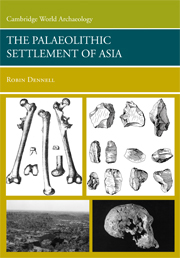Book contents
- Frontmatter
- Contents
- List of Tables, Figures, and Boxes
- Preface
- 1 Asia and Its Place in Palaeoanthropology
- 2 The African Background to the Colonisation of Asia
- 3 The Climatic and Environmental Background to Hominin Settlement in Asia before 1 MA
- 4 The Earliest Inhabitants of Southwest Asia
- 5 The Earliest Inhabitants of South and Southeast Asia and China
- 6 “Out of Africa 1” Reconsidered and the Earliest Colonisation of Asia
- 7 The Climatic and Environmental Background to Hominin Settlement in Asia between ca. 1 Ma and the Last Interglacial
- 8 The Middle Pleistocene Archaeological Record for Southwest and Central Asia
- 9 The Middle Pleistocene Archaeological Record of the Indian Subcontinent
- 10 The Middle Pleistocene Archaeological Record of China and Southeast Asia
- 11 Human Evolution in Asia during the Middle Pleistocene
- 12 Concluding Remarks
- Appendix 1 The Sizes of Countries and Regions in Asia, with Comparative Examples
- Appendix 2 Geographical Coordinates of Principal Early Palaeolithic Sites in Asia
- Appendix 3 Geographical Coordinates of Geological Sections and Cores
- Appendix 4 English Names of Various Mammals Recorded in Asia
- Bibliography
- Index
4 - The Earliest Inhabitants of Southwest Asia
Published online by Cambridge University Press: 05 June 2012
- Frontmatter
- Contents
- List of Tables, Figures, and Boxes
- Preface
- 1 Asia and Its Place in Palaeoanthropology
- 2 The African Background to the Colonisation of Asia
- 3 The Climatic and Environmental Background to Hominin Settlement in Asia before 1 MA
- 4 The Earliest Inhabitants of Southwest Asia
- 5 The Earliest Inhabitants of South and Southeast Asia and China
- 6 “Out of Africa 1” Reconsidered and the Earliest Colonisation of Asia
- 7 The Climatic and Environmental Background to Hominin Settlement in Asia between ca. 1 Ma and the Last Interglacial
- 8 The Middle Pleistocene Archaeological Record for Southwest and Central Asia
- 9 The Middle Pleistocene Archaeological Record of the Indian Subcontinent
- 10 The Middle Pleistocene Archaeological Record of China and Southeast Asia
- 11 Human Evolution in Asia during the Middle Pleistocene
- 12 Concluding Remarks
- Appendix 1 The Sizes of Countries and Regions in Asia, with Comparative Examples
- Appendix 2 Geographical Coordinates of Principal Early Palaeolithic Sites in Asia
- Appendix 3 Geographical Coordinates of Geological Sections and Cores
- Appendix 4 English Names of Various Mammals Recorded in Asia
- Bibliography
- Index
Summary
INTRODUCTION
Southwest Asia, at the crossroads of three continents, is critical for understanding the Early Palaeolithic of the Old World. Any hominin population leaving Africa would have had to pass through Southwest Asia on its way to Europe, Central Asia and Siberia, the Indian subcontinent, mainland Southeast Asia, China, Indonesia, and ultimately, for modern humans, Alaska and Australia. As population movements during the Early Pleistocene need not have been one-way, some hominin populations in Southwest Asia might also have entered Africa. (As we will see in Chapter 6, these may have included the earliest populations of H. erectus.) Southwest Asia, however, is more than an incidental stepping stone on the way to other areas. Its size and location justify us treating it as a subcontinent in its own right, along with Europe and South Asia. As Appendix 1 shows, this enormous region encompasses over six million square kilometres, or almost 2.5 million square miles, an area that is considerably larger than the EU, and almost twice the size of East Africa (Ethiopia, Kenya, Somalia, and Tanzania combined).
Climate and relief
Southwest Asia varies enormously in its climate and relief. Climatically, it lies west of the Indian summer monsoon (apart from the Yemeni Mountains), and is thus an area of winter/spring rainfall, most of which is delivered by westerly winds from the Mediterranean (see previous chapter).
- Type
- Chapter
- Information
- The Palaeolithic Settlement of Asia , pp. 82 - 127Publisher: Cambridge University PressPrint publication year: 2008



